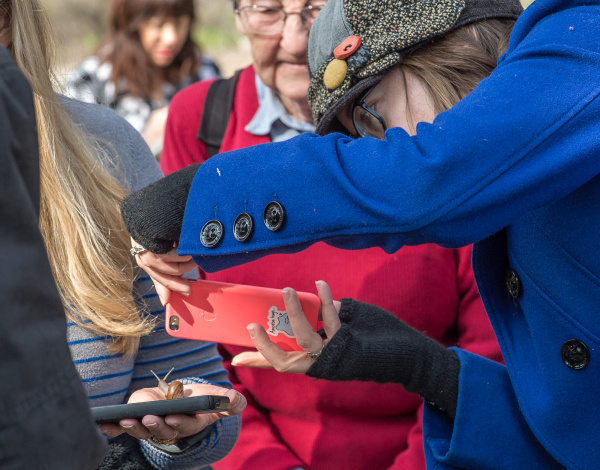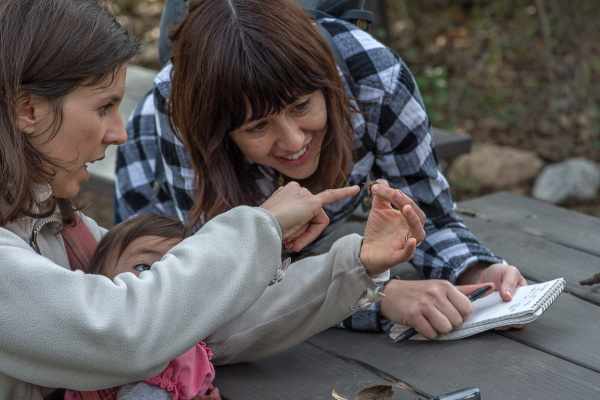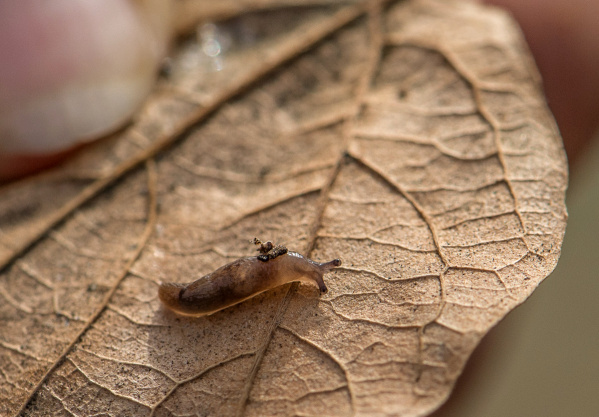Suddenly, the calm of Eaton Canyon was pierced by the shriek of delight from a young boy as he rose up from the ground where he had been poking through the leaves with a long stick. A crowd of adults gathered round as he cupped his hand and displayed his find which, on any other day, would have be easily dismissed. But not with this group. Not this day. This was a snail, a critter to be celebrated with oohs and awws.

Young and old citizen scientists were searching for snails and slugs as part of the official kick-off of the El Nino SnailBlitz, the newest program from the folks at the Natural History Museum of Los Angeles which has created one of the greatest monikers of all time: Snails and Slugs Living in Metropolitan Environments (SLIME). The program has a goal to receive 1,000 photographs of snails and slugs via social media by April 14. (Go to I Naturalist to post your photo or just use the hashtag #SnailBlitz on any social media.)

Documenting SoCal’s terrestrial gastropods has never been done before says Jann Vendetti, Ph.D. who is leading the cause for the NHM as their Twila Brathcer Endowed Chair in Malacological Research. “Most of the time when you see a snail or slug you wouldn’t care which species it is, or if it represented a potential invasive species,” she says about the 50 different snails and slugs (native and introduced) that call California home. “But now with this data we can gather information about this fauna we have in Southern California. It’s one of the overlooked natural biodiversity species in California – we need to know what is here.”

Vendetti admits that you can’t really compare the recent photographs of two adorable mountain lion kittens to discovering perhaps a new species of snail or slug – but the slow-moving slimers do have benefits. “They are easy to find, live right your backyard and are very photogenic – they don’t move around that quickly,” she says pointing to the critter’s eye stalks which gives them that alien otherworldliness.
Take THAT cute fuzzy kittens!


The soon-to-be-coming El Nino rains could bring a bevy of gastropods into backyards, fields, playgrounds and gardens – these are moisture-loving critters after all – and Vendetti hopes Angelenos embrace their slimy neighbors; she especially would like to see just how two “critically imperiled” species of snails are faring in SoCal: Glyptostoma gabrielense and Helminthoglypta traskii. Find a brown snail with a black band? That may be the gastropod equivalent of winning the Powerball.


But you may end up finding the more common garden snail, the bane of gardeners; these were originally imported from France as escargot and escaped. “European garden snails (Cornu Aspersum) arrived here from a small population that was brought here in the 1850s,” says Vendetti. “They made its way all the way here on its own,” she says alluding to the tenacity of the critters.
Indeed, other invasive snails came to SoCal not through fancy food imports but through gardening stores. You might never know what you are bringing home after a trip to OSH or Armstrong Nursery.


All and all, if you find a new species of snail and slug in the area, you could get your name in a scientific journal and all the bragging rights. Added lure to participate: the NHM is offering a series of prizes for photos (best snail photo, best slug photo, best snail/slug meme, rarest snail/slug). Grand prizes are being planned but one prize is to share a meal with Vendetti to talk more gastropod glow. We are pretty sure escargot will NOT be on the menu….
— Story by Brenda Rees, editor
— Unless noted, all photos by Martha Benedict

